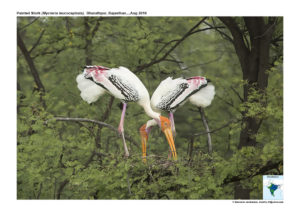Painted Stork

Painted Stork Mycteria leucocephala
Etymology:
- Mycteria : Greek word for Snout
- Leucocephala : Greek word Leuco –white ; Cephala – Head { White headed}
Vernacular Names:Sind: Lanjang, Lungduk, Hindi: Jangildhok, Sans: Chitritmahabak, Pun: Chitralamdhing, Bi: Kankari, Ben: Jangil, Ram jhankar, Sonajangha, Guj: Dhonk, Pilichanchdhonk, Kutch: Chitroda, Mar: Chitrablaak, Rangitkarkocha, Ratyatamb, Ta: Chengaalnaarai, Sanguvalainaarai, Te: Yerukalakonga, Mal: Varnakokku, Sinh: Daetuduwa
Distribution inIndia:Widespread resident in plains in India. Not seen in North West and North East India
Description: Size of 93-100 cm, wt. of 2-3.5 kg.It is a large stork having a heavy yellow beak with a down-curved tip. The head of the adult is bare and orange or reddish in colour. The long tertials are tipped in bright pink and at rest they extend over the back and rump. There is a distinctive black breast band with white scaly markings. The band continues into the underwing coverts and the white tips of the black coverts give it the appearance of white stripes running across the underwing lining. The rest of the body is whitish in adults and the primaries and secondaries are black with a greenish gloss. The legs are yellowish to red but often appear white due their habit of Urohydrosis .Males and females appear alike but the males of a pair are usually larger than the female. The immatureis pale brown with yellowish bill, and lacks pectoral band.
Habitat: It is found in shallow freshwater at a diversity of wetland types, such as lakes, grassy marshland, Lakes, riverbanks and paddy fields. Also found occasionally at coastal wetlands and in salt pans
Food Habits:It eats fish, of a diversity of species as available.Fish prey is usually 1–12 cm long, seldom larger than 20 cm. Also takes frogs, reptiles, crustaceans and insects. Foraging is in water up to 25cm deep. Feeding is largely tactile. Birds walk slowly moving the partly-open bill slowly from side to side. Food stirring and wing flashing are used to disturb prey. Normally feeds in pairs or small groups, except when prey abundant, as when pools are drying up during the dry season or following spawning activity after the monsoon
Breeding Habits: They breed in Nov-Jan.A colonial tree nester, colonies sometimes comprise 70–100 nests in only five or six trees, commonly in Babool tree, often over water. Nests are often almost contiguous. Sometimes nests in mixed colonies with Asian Openbill storks, herons, ibises or cormorants. The nest is a large stick platform with a central depression and lining of other plant matter. It lays a clutch of 3–4 eggs. The incubation period is 30 days and fledgingperiod is 60 days. During the mid-day heat, adults will stand at the nest with wings outstretched to shade the chicks. To feed chicks, adults regurgitate fish that they have caught and these are typically smaller than 20 cm long.Young chicks, when threatened, disgorge food and feign death by crumpling to the nest floor.